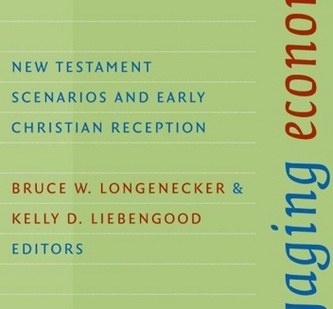Michael Kruse is well-known to the Jesus Creed blog, and here he plies his trade once again in a book review.
A variety of anthropological lenses have been used to examine the New Testament world but one lens remains relatively neglected … an economic lens. Scholars like Bruce Malina, K. C. Hanson, Douglas Oakman, and Justo Gonzalez are but a few that I’ve read that are trying to understand the economic world of the New Testament from the inside out. Now enters Engaging Economics: New Testament Scenarios and Early Christian Reception, edited by Bruce W. Longenecker and Kelly D. Liebengood.
Engaging Economics is a thirteen essay collection examining the economic dimensions New Testament theology. (Most of the essays came from the Bibilcial Studies Seminar at the University of St. Andrews in the spring of 2008.) Half of the essays examine the role of economics in the New Testament and the other half examine how Christians in the era immediately following the New Testament handled economic issues. Particularly noteworthy is that none of the contributors or editors is receiving any royalties from the book. All proceeds will be donated to World Vision.
Peter Oakes offers an opening essay that explores what is meant by economics and discusses the sources of economic evidence. One of the big challenges is the temptation to project our twenty-first century experience with a market economy back into the biblical context. What we would typically refer to as economic factors … supply and demand, utility, markets, etc. … were not categories through which the New Testament folks interpreted their world. There was no semi-distinct sphere known as the economy. Oakes writes:
“…For
example, the nature of patron-client relationships ensured constant distortion
of what we might expect to be market interaction. Distribution of resources was
dependent much more on power relationships than on the market.” (11)
Many
economists today see economics as a study of the choices that individuals and
societal entities make regarding limited resources. That may work for thinking
about modern economies but Oakes writes:
“… The focus
on choice is problematic in a society where most economic activities are
governed by custom or compulsion. I suppose it works fairly reasonably as long
as one remembers that the choices lie with the powerful elite. The stress on
incentives might be useful, but only if it is realized that, for most people,
they were generally of an ‘offer you can’t refuse’ type. …” (11-12)
Oakes
subscribes to the traditional characterization of economics as “the study of
the allocation of scarce resources” to be the most helpful in analyzing ancient
societies. (And if “scarce” is problematic to you in light of “abundance”
theology, substitute “limited” and you will be approximating what economists
have in mind.) It doesn’t presume that people have a wide array of choices.
An important
issue Oakes tackles is the view that Rome was ruled by elites while 99% of the
population living in abject poverty. Recent studies suggest there was more
stratification than this but it is hard to be precise. While society was hierarchical,
status and wealth did not perfectly coincide. Referencing the work of Steven J.
Friesen, Oakes suggests stratification likely looked something like this:
00.04% Imperial elites
01.00% Regional or provincial elites
01.76% Municipal elites. Includes some merchants.
07.00%? Moderate surplus resources. Includes some merchants,
some traders, some freedpersons some artisans (especially those employing
others), and military veterans.
22.00%? Stable near subsistence (with reasonable hope for remaining
above min. to sustain life.) Includes many merchants and traders, regular wage
earners, artisans, large shop owners, freedpersons, and some farm families)
40.00% At subsistence level (and often below minimum sustain
life) Includes small farmers, laborers, artisans (esp. employed), wage earners,
most merchants/traders, and small shop owners.
28.00% Below subsistence level. Includes some farm families,
unattached widows, orphans, beggars, disabled, unskilled day laborers, and
prisoners. (30)
David Horrell,
in his essay Aliens and Strangers?,
does further analysis of Friesen’s work concluding that approximately 80% of
the population lived very near or below subsistence levels. The way society was
stratified is very similar to societies in pre-industrial emerging nations
today. This general construct gives us some clues about the individuals and
groups we encounter in the text of the New Testament.
There isn’t
space here for me to review each essay but here is brief sampling to give a
flavor.
John Kloppenborg
presents Agrarian Discourse and the
Sayings of Jesus. He focuses on three types of reciprocity: general
(exchange between close kin and friends), balanced (quid pro quo market exchange) and negative (exploitive exchange).
Kloppenborg examines “measure for measure” statements like Luke 6:37-38:
37“Do
not judge, and you will not be judged. Do not condemn, and you will not be
condemned. Forgive, and you will be forgiven. 38Give, and it will be
given to you. A good measure, pressed down, shaken together and running over,
will be poured into your lap. For with the measure you use, it will be measured
to you.”
These are
drawn directly from the world of agrarian exchange and draw on balanced
reciprocity … not values of mercy or justice … to make their ethical point.
That is, they draw on the self-interest of the hearer to motivate them to action.
In Is God Paul’s Patron? The economy of
Patronage in Pauline Theology, David J. Downs takes on the metaphor of God
as patron with Christ as broker. Examining the language and nature of the
exchanges involved in Paul’s metaphors, Downs concludes that Paul’s
metaphorical rhetoric has been misunderstood. Rather Paul is using metaphor’s
from the context of the household and fictive kinship, where God is the father
and we are God’s children, not patron to client images.
One essay is
devoted to the idea of holding things in common in Acts but others touch on
this topic as well. There is also an examination of the economic dimension in
James.
In the
second half of the book the focus shifts to how the early church fathers read
the texts. Longenecker presents an interesting essay on Galations 2:10:
“All they
asked was that we should continue to remember the poor, the very thing I was
eager to do.”
Is Paul
referring to the poor in a particular geographic area or is Paul making a
broader theological statement about the poor? The former has tended to be the
conclusion of modern interpreters but Longenecker demonstrates that the early
church fathers had the later view.
Grant Macaskill
draws us to the critique of Rome presented in Revelation, which includes
critique of their economic activity. Yet the early church fathers were
virtually silent about the economic issues except in peripheral ways …
sometimes being more interested indentifying the Antichrist rather than the
critique. Macaskill says Revelation was focused on union with Christ and, “For
this reason it is not to be primarily judged as an attack on Rome so much as a
challenge to potentially complicit church.” (259) He concludes, writing:
“… The
trajectories of interpretation of Revelation among the early church fathers,
however, suggest that full integration into the Roman economic system may not
have been as troubling for the church as other aspects of Roman Life, notably
idolatry. With the single exception of Tertullian, the evidence suggests a
general tendency by the fathers to overlook the systemic importance of
economics.” (259)
As I read
this, I wanted to ask Macaskill in what sense he meant “systemic importance of
economics.” Without the records and constructs by which we do economic analysis
today, what would systemic analysis look like? As Oakes notes, our modern
concepts of economics are very recent (a little more than 100 years old.) I
wonder if we are assuming a lens that was not present to John or the early
Church fathers.
Another
essays looks at the development of the idea of almsgiving. Yet another explores
ascetic values from the Syriac Book of
Steps.
The book is
a great resource for exploring the economic dimensions of the New Testament. As
with any scholarly work, the essays are meticulously footnoted pointing readers
to other resources for further study and, as with any collection of essays, the
significance of the articles will vary according to the interests of the
reader. For anyone wanting a wider ranging provocative reader, this certainly
qualifies. It is great read.
(Significant
portions of Engaging Economics can be
previewed at Google
Books.)


